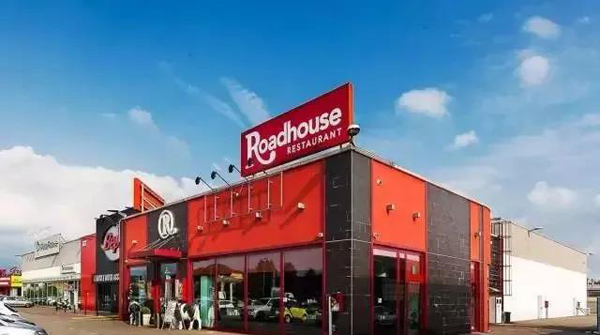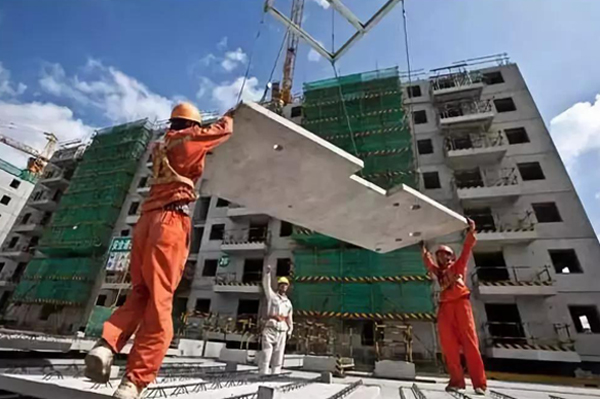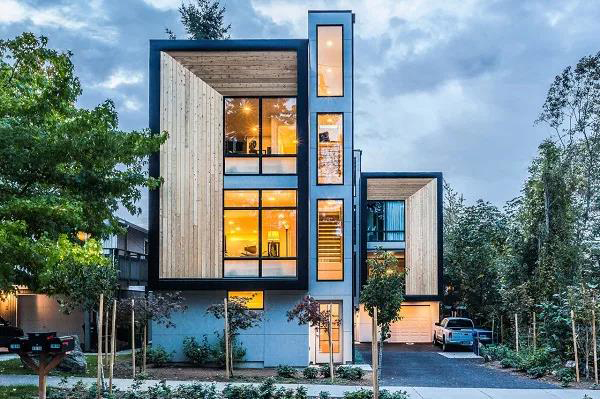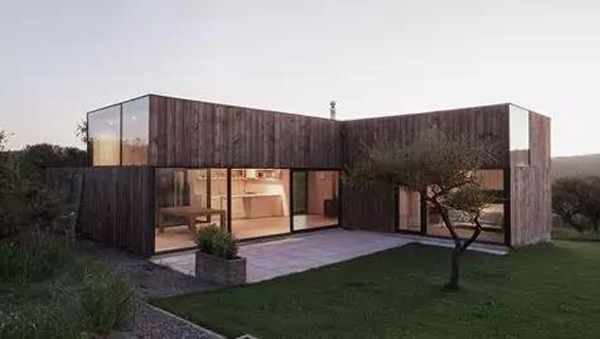Prefabricated buildings began to attract interest in the early 20th century and finally came to fruition in the 1960s. Britain, France, the Soviet Union and other countries made the first attempt. Because of the speed of construction of prefabricated buildings, and the low cost of production, it has been rapidly promoted around the world.
The shape of the early prefabricated buildings was stiff and monotonous. Later, design improvements were made to increase flexibility and variety, allowing prefabricated buildings to be built not only in batches, but also in a variety of styles. In the United States, there is a kind of mobile home, which is a relatively advanced prefabricated building, and each residential unit is like a large trailer, which can be used as long as it is pulled to the site by a special car, and then hoisted to the floor pad by a crane and connected to the embedded water channel, power supply, and telephone system. The mobile home has heating, bathroom, kitchen, dining room, bedroom and other facilities. The mobile home can be a single unit, but also can be connected to each other.

Characteristics of prefabricated buildings
1. A large number of building components, such as outer wall panels, inner wall panels, laminated panels, balconies, air conditioning panels, stairs, prefabricated beams, prefabricated columns, etc., are produced and processed by the workshop. Centralized production greatly reduces project costs and is more conducive to quality control.
2. The building parts produced by the factory are shipped to the site for assembly, which reduces the formwork and manual workload and speeds up the construction speed, which is of great significance for reducing the project cost.
3. Prefabricated construction turns the entire building from a project into a product. The more standard the components, the higher the production efficiency, the lower the cost, and with the digital management of the factory, the price of the entire prefabricated building is far from comparable to the traditional construction method.
4. Unlike traditional buildings, which must first finish the main body before decoration and decoration, prefabricated buildings can assemble the decoration parts of each prefabricated part after completion, realizing the synchronization of decoration and decoration works with the main project, reducing the construction process and reducing the project cost.
5. The selection of building materials for prefabricated buildings is more flexible, and the use of various energy-saving and environmentally friendly materials such as light steel and wood panels makes prefabricated buildings more in line with the concept of green buildings.

Types of prefabricated buildings
Block building
Prefabricated buildings built with prefabricated block materials are suitable for building 3 to 5 storey buildings, of course, if the strength of the block or the configuration of steel bars, the number of layers can be appropriately increased, but only low-rise buildings. However, its production process is simple, the construction is simple, the cost is low, but also the use of local materials and industrial waste, is the choice of small self-built houses!
Board building
It is composed of prefabricated large internal and external wall panels, floor panels and roof panels and other plates assembled, also known as large plate building. It can effectively reduce the weight of the structure, improve labor productivity, expand the use area of the building and anti-earthquake function, is the main type of prefabricated buildings.
Wall panels are divided into load-bearing wall panels and decorative wall panels, load-bearing wall panels are mostly reinforced concrete panels, decorative wall panels such as outer wall panels are mostly reinforced concrete composite panels with thermal insulation layer, and special steel and wood thermal insulation composite panels with external finishes. All kinds of plate hoisting assembly can be completed, the construction speed is fast, the construction price is low!
Box building
It is a prefabricated building developed on the basis of plate building. It is characterized by making all the room units or small cubicles, kitchens, bathrooms or stairwells into load-bearing boxes in the structure, and then forming a whole with wall panels and floor panels. This kind of building has a higher degree of factory construction, faster on-site installation, not only can the structural part of the box be completed in the factory, but also the internal decoration and equipment can be done, even furniture, carpets, etc., can be completed, and the site can be lifted and connected to the pipeline! There is even a prefabricated building called the mobile home, where each housing unit is like a large trailer, which can be used as long as it is pulled to the site by special cars, and then hoisted by a crane to the floor MATS and connected to the embedded water channel, power supply, telephone system, etc. And the interior has heating, bathroom, kitchen, dining room, bedroom and other facilities, it can be a single house, but also can be connected to become a whole house!
Skeleton plate building
It consists of prefabricated frames and plates. The load-bearing structure generally has two forms, one is the load-bearing frame composed of columns and beams, and then shelving the floor and non-load-bearing internal and external wall panel frame structure system; The other is a load-bearing plate-column structure system composed of columns and floors, and the inner and outer wall panels are non-load-bearing components. Load-bearing frame can be heavy reinforced concrete structure or heavy steel structure, light weight, flexible internal separation, suitable for multi-storey and high-rise buildings.
Raised panels and raised buildings
The structural system of this kind of building is jointly supported by slabs and columns. It is to pour floor slabs and roof slabs repeatedly on the bottom concrete ground, erect precast reinforced concrete columns, and use the columns as guide rods to lift the floor slabs and roof slabs to the design height, and then fix them. As for the internal and external walls, cast-in-place reinforced concrete can be used, brick walls can also be built, and other lightweight curtain walls can be installed. It moves a large number of cast-in-place processes to the ground, reduces aerial work and vertical transportation, saves formwork and scaffolding works, and reduces the construction site area, which is very suitable for buildings with limited construction sites, and is mostly used as shopping malls, warehouses, workshops and multi-storey garages.

Prefabricated buildings are more developed in the United States, Canada, Japan and some European countries. From the beginning of the 20th century, some North American countries such as the United States and Canada began to study and apply prefabricated buildings, and established the Precast/Prestressed Concrete Association (PCI) long-term research and promotion of prefabricated buildings. After that, the association issued many codes and standards on prefabricated buildings, which further promoted the development of prefabricated buildings and made them more widely used. In a large area of engineering practice, the prefabricated building has given full play to its advantages, reflecting the advantages of good quality, high efficiency, economy and durability.
The development of prefabricated buildings in Japan has reached the world's highest level, and Japan's construction-related standards and codes for prefabricated buildings are also perfect. In the development and application of prefabricated buildings in Japan, prefabricated buildings are applied to high-rise and super high-rise buildings in earthquake areas. In several sudden earthquakes, prefabricated buildings give full play to their advantages of earthquake resistance, ensure people's life safety, and get full attention.
Europe is the birthplace of prefabricated architecture, dating back to the 17th century. European countries have an early understanding of prefabricated buildings. Through continuous scientific development and technological innovation, they have developed relatively perfect ideas on construction methods, accumulated more experience, and compiled a series of engineering standards and application manuals for prefabricated buildings, which play an important role in promoting the development of prefabricated buildings.
In China, from the 1950s, people began to gradually understand and understand the prefabricated building, and in the early 1960s, people began to preliminarily study the construction method of prefabricated building, and formed a new building system. Through the continuous development of science and technology, until the 1980s, the development of prefabricated buildings in China can be described as reaching its heyday. However, due to the limitations and shortcomings of prefabricated buildings, coupled with the limited design level and construction level of China at that time, it can not keep up with the development needs of prefabricated buildings, until the 1990s, the application of prefabricated buildings in China was really popular in a large area, but there are still limitations in architectural design and construction management research. As a result, the development of the application of prefabricated buildings in our country is relatively slow.

With the development of modern industrial technology, the construction of houses can also be manufactured in batches, just like the production of machines! The prefabricated housing components are transported to the site for on-site assembly, which is prefabricated construction! Compared with traditional construction methods, its construction speed is fast, the construction quality is high and the cost is low, which is the development trend of a new generation of urban buildings, and the Ministry of Housing and Urban-Rural Development relies on it to control the price of housing!
| 上一条:10 easy to understand prefabricated construction knowledge points, construction field practitioners must read. | 下一条:Precautions for the use of saber saw |

 HOME
HOME
 Products
Products
 TEL
TEL